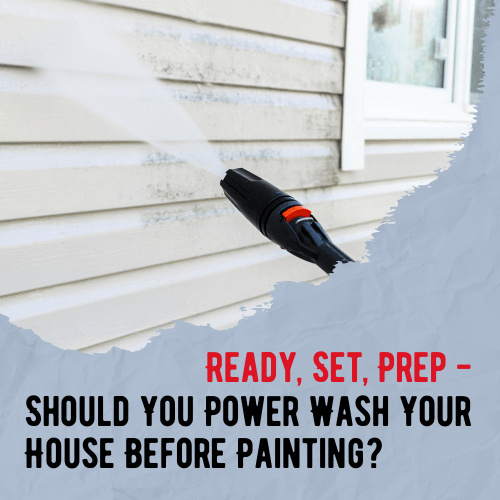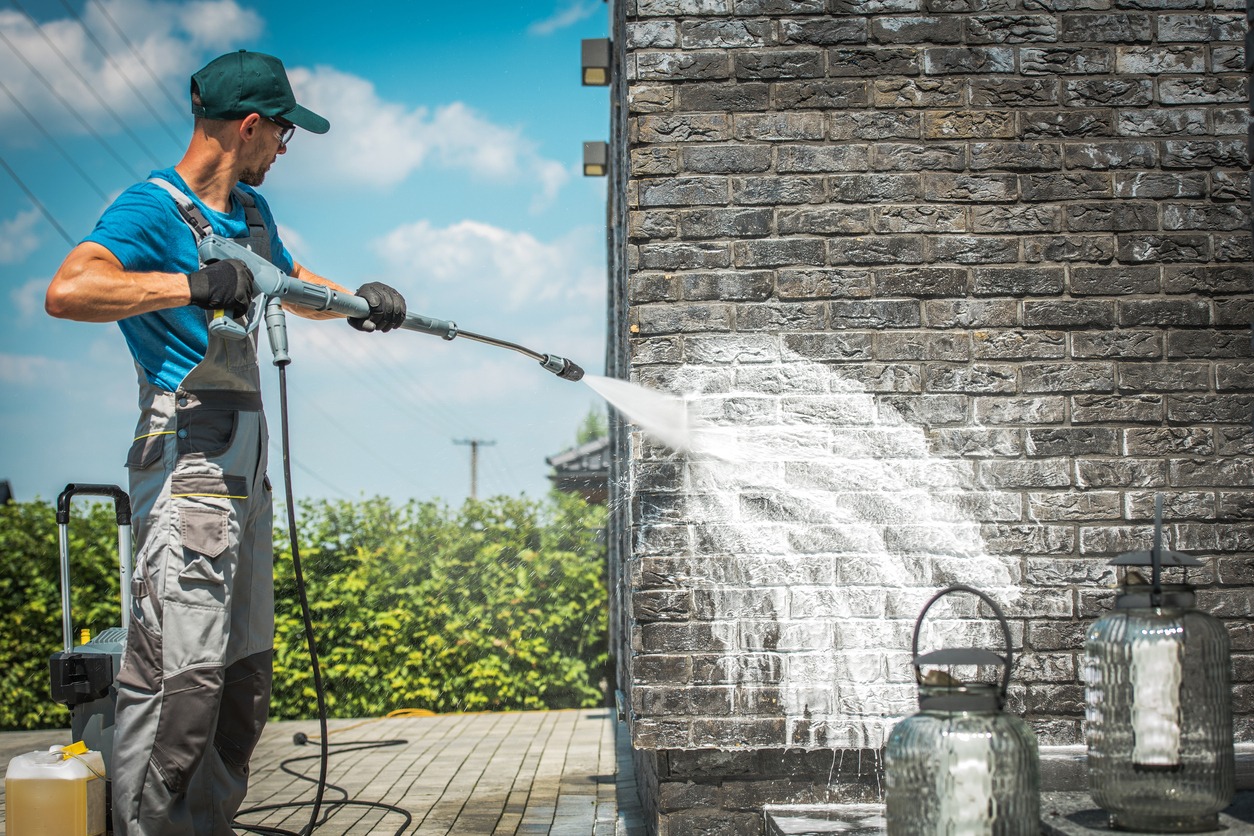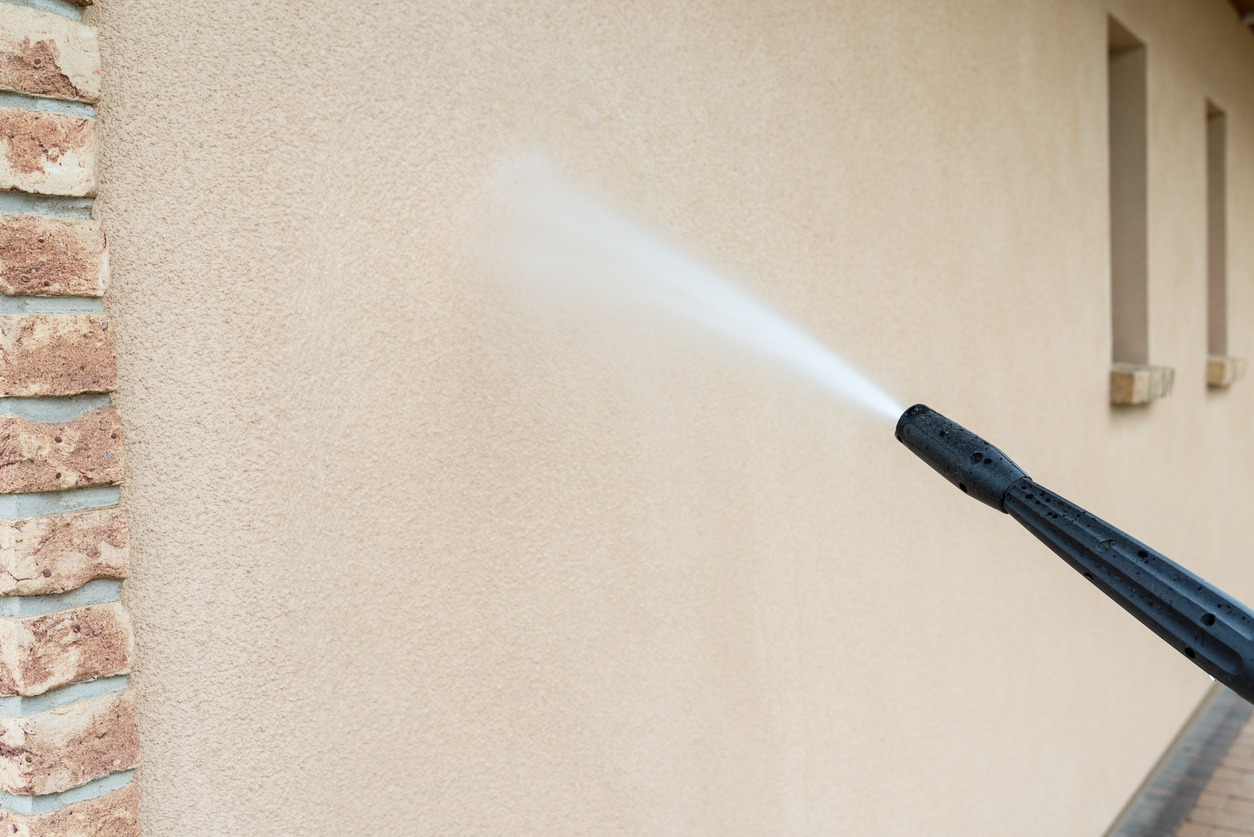Preparing your house for a fresh coat of paint is like setting the stage for a grand performance. Before the main event — painting — an important step might cross your mind: power washing. Is it necessary to give your house a thorough shower before dressing it up in a new color?
In this article, we’ll discuss pre-painting preparations, shining a spotlight on power washing. We’ll explore why this step could be the secret to a flawless finish and how it helps ensure your paint job looks great and lasts longer. Whether you’re a DIY enthusiast or planning to call in the pros, understanding the role of power washing can make all the difference. Let’s begin this journey to give your home the perfect makeover it deserves.
Understanding Power Washing
Power washing, often called pressure washing, is a cleaning method that uses high-pressure water spray to remove dirt, grime, mold, paint, and other types of debris from surfaces. This technique can be applied to various materials, including concrete, wood, brick, and siding, making it a versatile tool for exterior home maintenance.
At its core, power washing involves propelling water at high speeds to blast away unwanted substances from surfaces. The process utilizes a power washer machine, which can vary in strength from light-duty models perfect for small tasks to heavy-duty machines designed for more challenging projects. Power washing is distinct from pressure washing, which sometimes heats the water used, providing extra cleaning power that is especially effective against stubborn stains or substances.
The Benefits of Power Washing for Exterior Surfaces
Power washing offers several key benefits that make it an essential step in preparing your home’s exterior for painting:
- Thorough Cleaning: It removes layers of dirt and grime that normal cleaning methods can’t tackle, ensuring the surface is pristine.
- Mold and Mildew Removal: These common issues on exterior surfaces can be effectively eradicated with power washing, preventing potential health risks and damage to the paint over time.
- Prepares Surfaces for Painting: By creating a clean and smooth canvas, power washing ensures that paint adheres better and lasts longer, leading to a more durable and aesthetically pleasing finish.
- Increases Property Value: A clean exterior enhances curb appeal, potentially increasing your home’s value. It’s a simple yet effective way to make a positive impression.
- Saves Time: Compared to manual scrubbing and preparation, power washing is significantly faster, saving valuable time in the pre-painting process.
The Case of Power Washing Before Painting
Power washing serves as the ultimate preparation method by thoroughly cleaning and prepping surfaces. This process involves blasting water at high pressure to strip away dirt, grime, and other accumulated substances over time. It’s not just about cleanliness; it’s about creating a smooth and uniform surface that paint can adhere to easily. Without this step, the paint might not stick properly or could peel off prematurely, leading to a less-than-ideal finish and the need for frequent touch-ups.
The Types of Dirt, Grime, and Debris Power Washing Can Remove
The effectiveness of power washing lies in its versatility and power to remove a wide range of substances, including:
- Dirt and Mud: Years of accumulated dust and mud can embed into exterior surfaces, making them look dull and uninviting.
- Mold and Mildew: These can cause health issues and interfere with paint adhesion.
- Loose Paint: Removing chipping or peeling paint is essential for a smooth painting surface.
- Stains and Grease: Stains from trees, birds, and pollution, as well as grease spots, can mar the appearance and texture of exterior surfaces.
- Algae and Moss: These can cause damage over time and create a barrier between the paint and the surface.
By removing these elements, power washing ensures that paint goes on smoothly and bonds well with the surface.
The Impact of a Clean Surface on Paint Adhesion and Longevity
A clean surface is fundamental for successful painting projects. Here’s how a well-prepared surface impacts paint adhesion and longevity:
- Improved Adhesion: Paint adheres best to clean and smooth surfaces. Power washing removes any barrier that might prevent paint from sticking effectively.
- Enhanced Durability: When paint adheres properly, it’s less likely to crack, peel, or blister, even under harsh weather conditions.
- Uniform Appearance: Clean surfaces help ensure that paint looks even and consistent, without patches or stains showing through.
- Long-Term Savings: A paint job that lasts longer means fewer repaints and touch-ups, saving money and effort over time.
Considerations Before Power Washing
Before you decide to power wash your home, here are some of the things you need to consider:
- Assess the Surface Condition: Before power washing, examine the surface for any damage, such as cracks, loose bricks, or peeling paint. Power washing can exacerbate these issues if not addressed beforehand.
- Choose the Right Equipment: Select a power washer with the appropriate pressure settings for your project. Too high pressure can damage softer surfaces, while too low may not be effective on harder materials.
- Determine the Need for Detergents: Some cleaning tasks may require using detergents in addition to water. Decide if your project needs a cleaning solution and choose one suitable for your surface and the environment.
- Be Mindful of Plants and Landscaping: Water and detergents can harm plants and landscaping around your home. Cover plants or use a gentle spray setting near sensitive areas.
- Protect Windows and Doors: Ensure windows and doors are closed and properly sealed to prevent water from entering your home. Cover any vulnerable fixtures with plastic sheeting if necessary.
- Consider the Weather: Opt for a dry, mild day for power washing. Avoid washing on windy days, which can cause spray to disperse unevenly, and on very hot days, where the water may evaporate too quickly.
- Safety First: Wear protective eyewear, gloves, and appropriate footwear to protect yourself from the high-pressure water and any debris that might be dislodged during the process.
- Be Aware of Local Regulations: Some areas have water usage or discharge restrictions, especially concerning detergents. Check local regulations to ensure compliance.
- Professional Consultation: If unsure about any aspect of power washing, consider consulting with a professional. They can provide advice tailored to your specific situation or take on the job to ensure it’s done safely and effectively.
How to Power Wash Safely and Effectively
Power washing your home’s exterior is a powerful way to remove built-up dirt, grime, and other debris, preparing it for painting or simply maintaining its appearance. However, it’s important to approach power washing safely and effectively to prevent damage to your property and ensure a thorough cleaning. Here’s how to do it:
- Wear Protective Gear: Before you begin, equip yourself with safety glasses, gloves, and ear protection if using a gas-powered model. Wear long pants and sturdy shoes to protect your skin from debris and the high-pressure water stream.
- Prepare the Area: Remove or cover any outdoor furniture, decorations, and plants that might be in the way or damaged by water. Ensure windows and doors are closed and properly sealed.
- Choose the Right Nozzle and Pressure Setting: Power washers have various nozzles for different spray patterns and strengths. To prevent surface damage, use a wider angle nozzle (15 to 40 degrees) for general cleaning. Adjust the pressure setting based on the surface you’re cleaning; softer materials like wood require lower pressure.
- Test the Pressure Washer: Before starting on the surface you intend to clean, test the pressure washer on a small, inconspicuous area to ensure it doesn’t damage the material.
- Use a Consistent Technique: Keep the nozzle moving in smooth, overlapping strokes to clean the surface evenly. Holding the nozzle too close or spraying it in one spot for too long can etch or damage surfaces.
- Work in Sections: Divide your work area into manageable sections, and clean one section at a time. This helps ensure an even clean and prevents you from missing spots.
- Apply Detergents Appropriately: If using detergents, apply them to the surface from the bottom up to prevent streaking. Allow the cleaning solution to sit for a few minutes to break down the dirt before rinsing.
- Rinse Thoroughly: Rinse the surface thoroughly with clean water after washing or applying detergent. Start from the top and work down to ensure all detergent and loosened debris are washed away.
- Inspect and Touch Up: Inspect your work once the area is clean and dry. You may need to touch up missed areas or require more attention.
- Maintain Your Equipment: Properly clean and maintain your pressure washer according to the manufacturer’s instructions. This includes draining any remaining water to prevent internal damage and storing the unit in a safe, dry place.
Following these steps, you can power wash your home safely and effectively, preparing it for a fresh coat of paint or keeping your exterior looking its best.
Conclusion
Power washing is a powerful tool for maintaining the beauty and longevity of your home’s exterior. Whether you’re prepping for a paint job or simply aiming to keep your property pristine, it’s important to approach this task with care. However, for those who are unsure or would prefer a professional touch, consulting with experts can ensure the job is done safely and effectively without risking damage to your property. If you’re looking for professional power washing services, don’t hesitate to call Custom Painting, Inc. at 925-294-8062 or complete our online contact form. Let us help you make your home look its best with the care and expertise it deserves.



